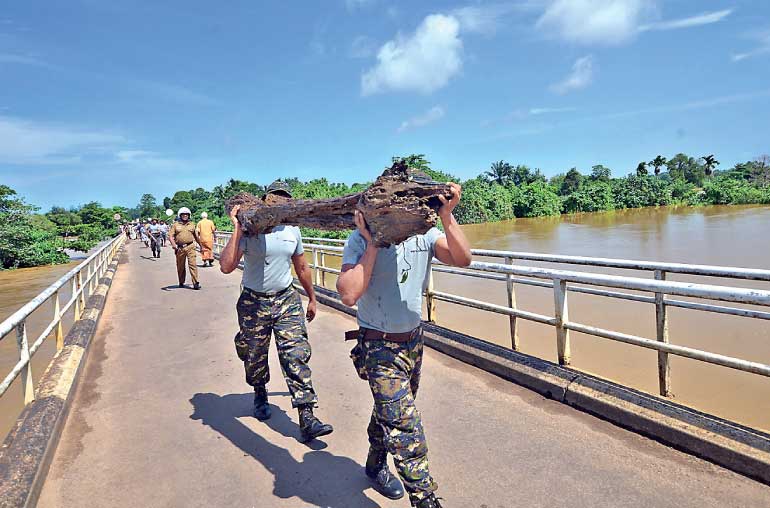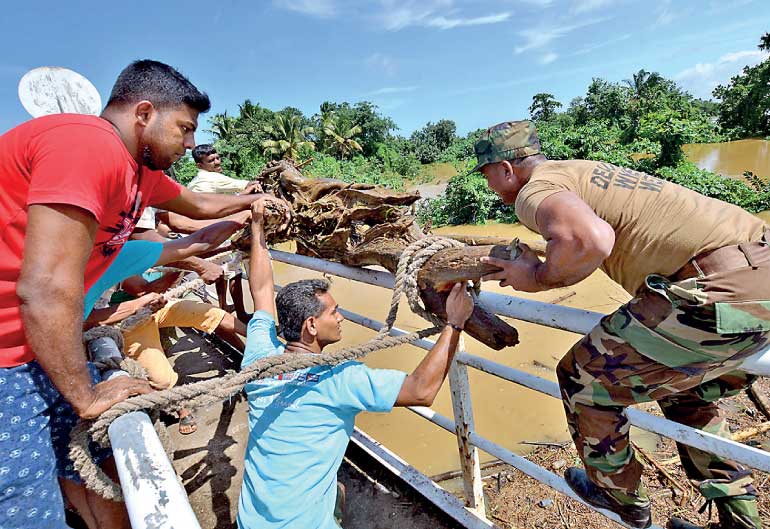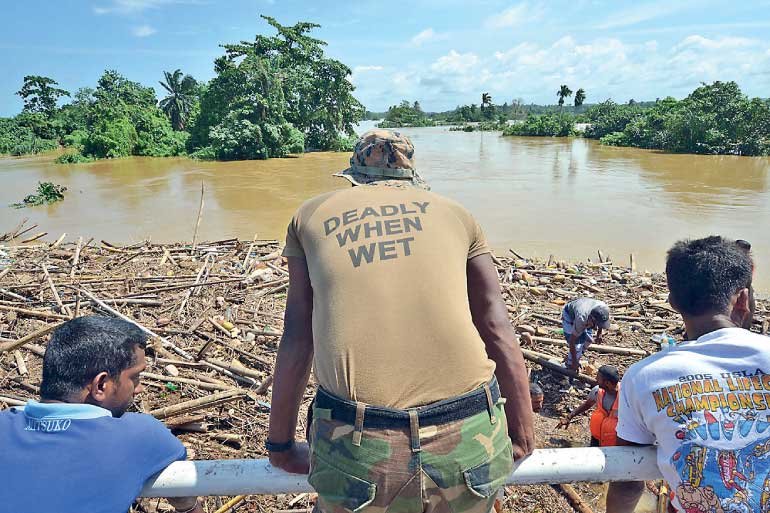Monday Dec 29, 2025
Monday Dec 29, 2025
Monday, 5 June 2017 00:01 - - {{hitsCtrl.values.hits}}

By T. Mallawatantri
The warning came as a somewhat innocuous weather forecast on 24 May predicting heavy rains and gusty winds in many districts in the south west monsoon belt due to the monsoon conditions getting activated.
The Disaster Management Centre warned people in Sabaragamuwa, Southern, and certain parts of Western Province to be vigilant about heavy rains and floods caused by rising levels in many rivers and possible landslides in lower slopes of hilly terrain in vulnerable areas.
By 25 May, the rains came lashing down with gale force winds causing havoc in many areas in the south, Sabaragamuwa and parts of the Western Province, rendering many people homeless and some succumbing to death by landslides which buried entire households with people in them.
The situation was aggravated by the influence of severe depression in the Bay of Bengal, slowly developing into a tropical cyclone which was later named ‘Mora’. By this time, thousands were made homeless and they sought shelter in temples and schools. The number of missing persons and the death toll was rising rapidly.
In this devastating situation, the Grama Niladharis in affected areas got activated and started relief work with the first signs of disaster. They were guided by the Divisional Secretaries and officials of the Disaster Management Centre.
The venerable priests in charge of many temples where people sought refuge, provided the basic needs to them with the assistance of Dayakas and well-wishers. Likewise, mosques, churches and religious places of worship in the vicinity of affected areas too provided whatever assistance they could muster. The local Police contributed in no small measure in the relief operations thus carried out.
By the time the initial relief operations were in progress, the flood situation worsened and landslides became numerous with heavy rains striking the central hills and lower slopes of mountain regions with as much as 560 mm of rain, thus making the rivers flowing down a deluge, submerging everything in its wake.


The Disaster Management Centre by this time activated the disaster recovery procedures and were enlisting the services of the defence forces, namely Army, Navy and the Air Force. The 1990 Emergency Healthcare Ambulance Service was also called up to assist the victims affected by injuries and other illnesses in the affected areas. The transport of patients in many places to hospitals was carried out by the 1990, Suwa Seriya Ambulances. Some of the Health Department ambulances in hospitals too were mobilised.
The Army with assistance from the Police did a tremendous job in searching for landslide victims, often risking their own lives and taking the rescued persons to safety and dispatching them to hospitals in 1990 and Health Department ambulances.
The Navy ran rescue missions to save marooned people from the flood waters and distribute food and essential items going by boat or wading in the flood waters. The Air Force was not second in their commitment and they ran rescue missions from several helicopters and carrying essential food, water and medicines to needy people. One airman on a rescue mission lost his life just after rescuing an elderly lady to safety.
It was a heart-warming sight to see the 1990 ambulance crews wading in the flood waters pushing a gurney with a patient and at times administering first aid to needy children and adults who were affected by the disaster. The ambulance drivers or pilots, as they are called in the 1990 service, skilfully manoeuvred the ambulances in partly submerged by-roads to fetch injured people. They were young people trained to administer emergency pre hospital care to needy people and they rose to the occasion in an exemplary manner. These young people as well as the defence services personnel worked continuously without even a break for rest to bring relief to the affected people. These crews debunked the reservations expressed by certain quarters in the health sector on their competency, earlier when the service was launched.
Several media institutions using their reach to viewers and listeners did a tremendous job by seeking and collecting dry rations to the flood affected victims along with other voluntary organisations, the response of the people being astounding and certainly helped in the relief efforts in providing essential items like drinking water, milk food, medicines, blankets, etc. The assistance from friendly countries too helped to strengthen our ability to provide quick relief to the people in distress.
Though some criticise the presence of political leaders in the stricken areas, it certainly was a motivating factor to the defence personnel, public officials and voluntary workers. Politicians trying to make capital out of the situation were comparatively small but most political figures who got involved appeared to be genuinely helping the effort.
So, the Grama Niladharis, priests of temples and places of religious worship, Police, Army, Air Force, Navy, the ambulance crews, district and divisional secretaries, officials of many ranks and public servants rallied to render selfless assistance and relief to many people displaced and subject to distress by the extreme bad weather and these officials and personnel performed in difficult conditions themselves, some even affected personally by the disaster and these are certainly unsung heroes of our times.
They did not perform these tasks entrusted to them to gain publicity but did so with commitment and genuine intention of helping those in distress. So it is up to us, the bystanders, to extend whatever assistance we can to bring back the normal life to those affected by this disaster.